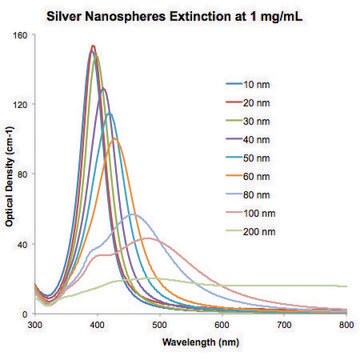All Photos(1)
About This Item
Linear Formula:
Ag
CAS Number:
Molecular Weight:
107.87
EC Number:
MDL number:
UNSPSC Code:
12141740
PubChem Substance ID:
NACRES:
NA.23
Recommended Products
Quality Level
form
colloidal
concentration
65-75% Ag
resistivity
1.59 μΩ-cm, 20°C
bp
2212 °C (lit.)
mp
960 °C (lit.)
density
10.49 g/cm3 (lit.)
SMILES string
[Ag]
InChI
1S/Ag
InChI key
BQCADISMDOOEFD-UHFFFAOYSA-N
Application
- Silver nanoparticles and their antibacterial applications: A study that delves into the antibacterial properties of silver nanoparticles, highlighting their potential in combating bacterial growth and infection (Bruna et al., 2021).
- Similarities and differences between silver ions and silver in nanoforms as antibacterial agents: Analyzes the mechanisms by which silver ions and nanoparticles exert their antibacterial effects, offering insights into their functional differences and similarities (Kędziora et al., 2018).
signalword
Warning
hcodes
pcodes
Hazard Classifications
Aquatic Acute 1 - Aquatic Chronic 1
Storage Class
13 - Non Combustible Solids
wgk_germany
WGK 3
flash_point_f
Not applicable
flash_point_c
Not applicable
ppe
Eyeshields, Gloves, type N95 (US)
Choose from one of the most recent versions:
Already Own This Product?
Find documentation for the products that you have recently purchased in the Document Library.
Customers Also Viewed
T Prameela Devi et al.
Indian journal of experimental biology, 51(7), 543-547 (2013-08-01)
A total of 75 isolates belonging to five different species of Trichoderma viz., T. asperellum, T. harzianum, T. longibrachiatum, T. pseudokoningii and T. virens were screened for the production of silver nanoparticles. Although all the isolates produced nanoparticles, T. virens
Muthusamy Prabhu et al.
Journal of nanoscience and nanotechnology, 13(8), 5327-5339 (2013-07-26)
In this study, silver-doped silica- and phosphate-based nanobioactive glass compositions (58SiO2-(33- x)CaO-9P2O5-xAg2O) (x = 0, 0.5, 1, 2 and 3 mol%) were synthesised by a simple and cost-effective sol-gel method. The prepared samples were characterised by X-ray diffraction, Fourier transform
S S Sudha et al.
Indian journal of experimental biology, 51(5), 393-399 (2013-07-05)
Silver nanoparticles is known to have antimicrobial affects. Cyanobacteria isolates from muthupet mangrove includes Aphanothece sp, Oscillatoria sp, Microcoleus sp, Aphanocapsa sp, Phormidium sp, Lyngbya sp, Gleocapsa sp, Synechococcus sp, Spirulina sp with were set in compliance with their cellular
Ii-Ho Kim et al.
Journal of nanoscience and nanotechnology, 13(5), 3660-3664 (2013-07-19)
Ag-dispersed Bi0.5Sb1.5Te3 was prepared successfully by silver acetate (AgOAc) decomposition and hot pressing. The Ag nanoparticles were well-dispersed in the Bi0.5Sb1.5Te3 matrix, and acted as phonon scattering centers effectively. The electrical conductivity increased systematically with increasing amount of Ag nanoparticle
Abhijeet Mishra et al.
Journal of nanoscience and nanotechnology, 13(7), 5028-5033 (2013-08-02)
The primary challenge in developing nanoparticle based enzymatic devices is to be able to chemically immobilize an enzyme, which will retain its activity or improve its function while being attached to the nanoparticle. This would be of even greater significance
Our team of scientists has experience in all areas of research including Life Science, Material Science, Chemical Synthesis, Chromatography, Analytical and many others.
Contact Technical Service





